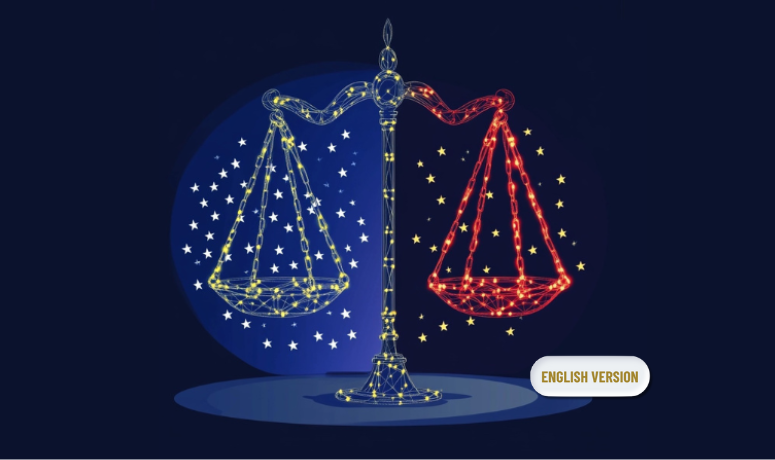« L’humeur de » invites you to discover the thoughts of a UGGC Lawfirm partner on subjects related to his or her expertise. In this latest edition, Anne-Marie Pecoraro looks back at the protection of cultural creation in France, which has inspired other countries at the European level.
In 2007-2008, the American writers’ strike left its mark on fans of Hollywood series, with many programmes being hastily cancelled for lack of sufficiently written episodes. Fifteen years on, will the new Writers Guild of America’s strike, which has paralysed the production on the other side of the Atlantic since the beginning of May 2023 (especially since it has historically been joined by actors’ unions.), be as noticeable to contemporary audiences, who are used to a sustained supply of new films and series distributed via streaming? While the influence of the United States on pop culture remains strong, Europe regularly produces works that are massively successful internationally, such as the celebrated Dix pour cent, the Lupin series (Netflix), the film Medellin (Prime Video) and Miraculous, to name but a few French examples.
The wide range of never-before-seen films and series available at the click of a mouse testifies to the vitality of popular, multiple, and transnational production. In such a context, the ability to develop and then control our intellectual property is an essential asset for Europe. With its rich cultural heritage and its tradition of critical thinking, Europe can take advantage of this precious resource in a globalised and highly competitive context.
Maintaining the economic driver
Industries based on knowledge and innovation create skilled jobs and stimulate growth. The development of intellectual property in Europe is therefore also an economic driver that needs to be supported by investing in research and development to maintain competitiveness, diversification, and the emergence of young talent. This is where certain aspects of the famous French cultural exception come into play, this set of measures designed to protect and promote cultural diversity: it has always been essential to maintain appropriate incentive and funding mechanisms, such as support for independent films, co-productions between European countries and specific distribution and promotion initiatives to encourage independent creation to enter the market.
Increased cooperation between European countries can take the form of co-productions, but also exchanges of best practice to create more ambitious and above all more visible projects: guaranteeing their access to a wider audience is essential. Platforms certainly represent competition, but they also represent an opportunity for European audiovisual production to be financed and distributed worldwide. Appropriate regulation should be encouraged to balance competition and protect the rights of creators and audiences alike: broadcast quotas, tax incentives and financial aid are used to support independent producers and European filmmakers.
There is immense talent on both sides of the Atlantic, and audiovisual law has succeeded over the decades in accompanying them and encouraging fruitful exchanges.
European mechanisms for creation
In France, the cultural exception enables audiovisual production to remain strong in the face of the globalised American market. Inspired by this strategy, the Old Continent has long put in place mechanisms to protect European cultural diversity. At the opening of the last Cannes Film Festival, the European Commissioner for the Internal Market, Thierry Breton, pointed out that international streaming platforms have distinguished themselves by a policy of buying up European intellectual property rights, and went on to recommend that the independence of production and European control of intellectual property should be preserved, given that it is both a cultural and an economic asset. This means extending the cultural exception from France to Europe.
In addition, France has actively lobbied for the inclusion of culture in international trade agreements, particularly during the negotiations at the World Trade Organisation, thereby strengthening the presence of European films on international markets, including the United States.
The European rules on State aid are designed to prevent distortions of competition within the single market of the 27 Member States. However, the EU recognises the need to support the cultural and creative sectors. The French model of cultural exception has also influenced the important European Directive on Audio visual Media Services (AVMS), adopted in 2018. This text incorporates provisions largely inspired by the French model to protect cultural and linguistic diversity through advanced mechanisms.
The constant evolution of digital technologies raises new challenges for the regulation and protection of cultural diversity. Among the claims of American writers and actors on strike in the summer of 2023, the regulation of the use of artificial intelligence, both in writing and in production, is a key issue. Europe will not be exempt from this debate: creating content with limited human intervention opens up the risk of a reduction in cultural diversity, and these technologies need to be regulated to ensure that creations made with the help of AI are rigorously supervised, as traditional productions have been. Both the public and rights holders must be protected, and our cultural exception gives us the experience and legitimacy to make our voices heard.






